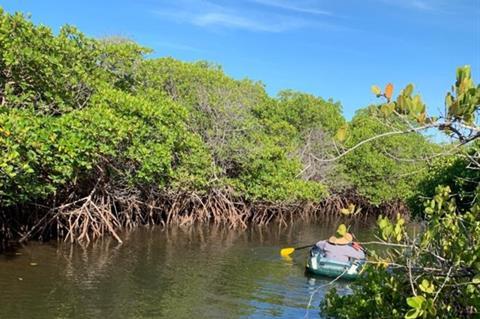Antibiotic resistance genes have been found deep in sediment within mangrove areas in Mexico, a new study has found.
The research by a team at Universidad Autónoma de Chihuahua, was published in a paper ’Antibiotic resistance profile in sediments and bacterial isolates from a human-impacted mangrove from Bahía Magdalena, Mexico’ which appeared in Sustainable Microbiology, an Applied Microbiology International publication.

Corresponding author Dra. Guadalupe Virginia Nevárez-Moorillón said the increase of antibiotic-resistant bacteria in the environment risks the emergence of resistant pathogens that can be resistant to the antibiotics used to treat infectious diseases nowadays.
Semi-arid mangrove
“Among the many ecosystems that can harbor antibiotic-resistant bacteria, we studied the sediments of a semi-arid mangrove area on the Pacific coast of Baja California, Mexico,” she said.
“The main purpose was to assess whether the mangrove sites closer to human settlement would harbor more antibiotic-resistant bacteria and antibiotic-resistance genes. Results showed no differences between the sites analyzed in terms of the number of antibiotic-resistant bacteria.
“Also, the antibiotic resistance genes present did not correlate with the phenotypic profile from the bacterial isolates. Mangroves are special ecosystems that, among other properties, can mitigate the dispersion of antibiotic-resistant bacteria, but further studies are needed to prove this idea.”
Antibiotic-resistant bacteria
The prevalence of antibiotic-resistant bacteria is considered a public health problem since the increase of pathogens resistant to multiple antibiotics is rising.
The presence of antibiotic-resistant bacteria in diverse environments can act as a reservoir for the genetic information of the mechanism of resistance that can later find their way to pathogenic bacteria, she said.
“The question was if human activities such as tourism or populations can lead to an increase of antibiotic-resistant bacteria in the ecosystem. Mangroves are ecosystems with interesting interactions between plants, animals, and microorganisms. We wanted to determine if the presence of human-related activities was related to the presence of antibiotic-resistant bacteria and antibiotic-resistance genes.”
Sediment sampling
Bacterial isolates were obtained from mangrove sediments at two locations in the Bahia Magdalena site in Baja California, Mexico, and tested for their phenotypic resistance to six different antibiotics. The sediment samples were taken at different depths, from the surface to up to 50 cm. Bacterial strains were tested for antibiotic-resistance genes by PCR. DNA was extracted from the sediments and tested for antibiotic-resistance genes.
A total of 90 bacterial isolates that were resistant to at least three antibiotics were obtained from the sediments tested. A high percentage was resistant to antibiotics commonly used to treat human infections (ciprofloxacin, cefotaxime); also, genes for antibiotic resistance were found in the same bacteria, although not necessarily for the antibiotics they were resistant to.
Genes for antibiotic resistance were found in sediments, even in deep sediments. One gene related to multiresistance in clinical settings (Class 1 integron) was found in a higher proportion in shallow sediments.
Surprising pattern
Dra. Nevárez-Moorillón found it surprising that in general, there was no significant correlation between the antibiotic resistance of the bacterial isolates and the presence of the genes tested for that particular antibiotic.
“Therefore, mechanisms other than the ones we tested could be responsible for those bacteria’s resistance to the presence of antibiotics in the mangrove. Also, other less-studied antibiotic-resistance genes can be present in environmental bacteria,” she said.
The next step will be to carry out further studies on mangrove sites with different degrees of deterioration by anthropogenic activities to provide more information on the dispersion of antibiotic resistance genetic information in the environment.
Survival of bacteria
“Also, it would be interesting to further study the effect of particular biotic and abiotic factors of mangroves on the survival and dispersion of antibiotic-resistant bacteria,” she said.
“The mechanism of antibiotic resistance by the bacterial isolates obtained can also help determine the risk they pose to human health. The quantification of antibiotic residues used in human therapeutics, in the mangrove sediments can also help to complete the picture of the problem of antibiotic release in the environment and the effect on the ecosystems.”
The study is part of a multidisciplinary project funded by the Consejo Nacional de Humanidades, Ciencias y Tecnologías, Mexico (FORDECYT Grant No. 297585). The lead institution is the Center of Biological Research from Northwest (CIBNOR), located in Baja California, Mexico. Other participating institutions are the CICESE (Interdisciplinary Center of Marine Sciences), and the Autonomous University of Baja California Sur, along with the Autonomous University of Chihuahua.
The main objective of the research is to show the resilience of mangroves to climate change, and the effect of human activities on the health of the ecosystem. At the University of Chihuahua, Dra Nevárez-Moorillón is responsible for the research group. The group’s main objective is to assess the effect of anthropogenic activities on the ecosystem and the risk to human health under the One Health approach.
’Antibiotic resistance profile in sediments and bacterial isolates from a human-impacted mangrove from Bahía Magdalena, Mexico’ appears in Sustainable Microbiology.
Topics
- Antimicrobial Resistance
- Applied Microbiology International
- Autonomous University of Baja California Sur
- Autonomous University of Chihuahua
- Bacteria
- Baja California
- cefotaxime
- Center of Biological Research from Northwest
- ciprofloxacin
- Class 1 integron
- Clean Water
- Climate Action
- Community
- Consejo Nacional de Humanidades
- Guadalupe Virginia Nevárez-Moorillón
- Healthy Land
- Interdisciplinary Center of Marine Sciences
- Ocean Sustainability
- One Health
- Research News
- Sustainable Microbiology
- The Americas
- USA & Canada







No comments yet